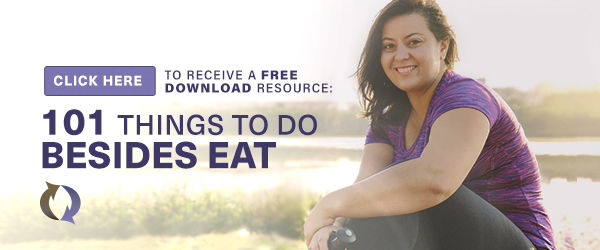“Black and white thinking” is the tendency to think in extremes. This false “either-or” dilemma plagues our culture’s approach to eating (and many other things). Let’s consider the detrimental effects of black and white thinking on eating.
Psychologists call extreme black and white thinking dichotomous thinking. It is also sometimes referred to as binary thinking or duality. Examples of dichotomous thinking include:
- Either or
- Good or bad
- Right or wrong
- All or nothing
Black and white thinking and eating
Examples of the effects of black and white thinking on eating include:
- I’m being good or I’m being bad.
- I’m either in control or I’m out of control.
- I’m eating right or I’m eating wrong
- I’m “letting myself” eat everything I love or I’m not allowed to eat anything I love.
On the diet or off the diet
 Black and white thinking has characterized yo-yo dieting for decades.
Black and white thinking has characterized yo-yo dieting for decades.
At first, dieters are highly motivated to adhere to a strict diet of “good” foods. Eventually, feelings of deprivation set in, leading to preoccupation and cravings for “bad” foods, increasing sensitivity to temptations, giving in, guilt, and consequently, overeating.
I call this predictable pattern the eat-repent-repeat cycle.
One familiar version of this cycle is holiday overeating followed by New Years resolutions.
Ironically, it is the false dilemma—either on the diet or off the diet—that reinforces the guilt and fear that fuel the eat-repent-repeat cycle. The reality is that, unless you know some fancy tricks, a yo-yo never stops in the middle.
A sustainable balanced lifestyle is a long-term process, not a short-term pledge of perfection.
A pendulum instead of a yo-yo
 That’s why I prefer to think of eating and physical activity as a pendulum instead of a yo-yo. It’s easy to picture what happens when you draw a pendulum in one direction and let go: it swings to the opposite extreme.
That’s why I prefer to think of eating and physical activity as a pendulum instead of a yo-yo. It’s easy to picture what happens when you draw a pendulum in one direction and let go: it swings to the opposite extreme.
Rather than seeing your choices in extremes – as either good or bad, right or wrong, all or nothing – small changes practiced consistently allow the pendulum to gradually find a smaller arc in between the extremes.
An eating and activity plan that takes into account your health concerns, preferences, schedule, goals, cultural, and other personal matters, make it possible to establish a lifestyle that’s flexible enough to withstand the realities of daily life in our abundant food environment.
Contrary to what some claim, balanced eating cannot be reduced to a rigid and overly simplistic prescription for what to eat and how much to exercise. Further, health doesn’t require perfect eating (whatever that is) anyway. It does, however, necessitate mindful eating.
From shades of grey to great!
Between a black and white approach to eating, mindful eating is a dynamic, flexible approach that embraces curiosity, non-judgment, and the grey areas.
The Am I Hungry? approach to mindful eating encompasses the entire decision making process, including:
- Paying attention to hunger and fullness cues
- Recognizing emotional and environmental triggers for eating
- Using nutrition information as a tool, not a weapon
- Choosing food that reflects balance, variety, and moderation for optimal nourishment and enjoyment
- Appreciating the appearance, aromas, and flavors of food
- Noticing how different foods, ingredients, and quantities affect satiety, energy, and pleasure
- Learning from mistakes rather than shaming, blaming, or judging
- Engaging in regular, joyful physical activity
- Practicing consistent self-care that decreases vulnerability to stress and coping behaviors
- Giving up the dichotomy of being in control or out of control, and choosing to be in charge instead
When you look for the shades of grey in place of old black and white thinking, you will discover how colorful your life can be!
This article is updated from a previous version.
If you enjoyed this article, here are three more to help you:
All or Nothing Thinking: Don’t Sabotage Your Exercise Plans
Ban the words “indulge” and “cheat”
How to Rewire Your Brain to Change Your Habits


